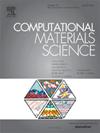高燃耗UO2燃料重整的中尺度模拟
IF 3.3
3区 材料科学
Q2 MATERIALS SCIENCE, MULTIDISCIPLINARY
引用次数: 0
摘要
本工作旨在模拟高燃耗燃料不同区域的重构行为,为高燃耗UO2燃料暗区和边缘区域提供了首个重构模型。我们采用了一个基于大电位的相场模型来同时评估亚颗粒的形成和裂变气泡在燃料中的生长。引入基于能量的亚晶形成准则来模拟重构过程。系统地研究了不同初始条件和不同建模参数对结构燃料特性的影响。亚晶粒的形成被观察到从现有的裂变气泡周围开始,并向三重结、晶界和晶粒内部发展。结构调整受初始位错密度、燃耗速率、亚晶形成速率和温度的共同影响。在一定的亚晶形成速率下,随着燃料温度的升高,结构调整速率增加。由于比较不同晶粒时缺陷积累的差异,在微观结构中观察到重构偏差。通过将模型参数化,根据燃耗速率和温度确定相应的缺陷产生率,可以得到暗区和边缘区对应的微观结构。此外,气泡的大小和分布对重组率没有显著影响。预测的微观结构与重构区域的实验观察结果一致。最后,我们提出了一个相关性,表明重组体积分数的演变是局部燃耗的函数。本文章由计算机程序翻译,如有差异,请以英文原文为准。

Mesoscale modeling of restructuring in high burnup UO2 fuel
This work aims to simulate the restructuring behavior observed in different regions of high burnup fuel, providing a first-of-its-kind restructuring model for the dark zone and rim region of high-burnup UO fuel. We employed a grand-potential-based phase-field model to concurrently evaluate subgrain formation and the growth of fission gas bubbles within the fuel. An energy-based subgrain formation criterion was introduced to simulate the restructuring process. The effects of different initial conditions and different modeling parameters were systematically studied to capture how each of these parameters influences the characteristics of the restructured fuel. Subgrain formation was observed to begin around existing fission gas bubbles and proceed toward triple junctions, grain boundaries, and grain interiors. Restructuring was demonstrated to be influenced by a combination of initial dislocation densities, burnup rate, subgrain formation rate, and temperature. Under a given subgrain formation rate, the rate of restructuring increases with rising fuel temperature. A restructuring bias was observed within the microstructure, due to the variation in defect accumulation when comparing different grains. Microstructures corresponding to the dark zone and rim region can be obtained by parameterizing the model with the appropriate defect production rate, as determined based on the burnup rate and temperature. Furthermore, bubble size and distribution do not significantly affect the rate of restructuring. The predicted microstructures are consistent with experimental observations of the restructured regions. Finally, we present a correlation demonstrating the evolution of the restructuring volume fraction as a function of local burnup.
求助全文
通过发布文献求助,成功后即可免费获取论文全文。
去求助
来源期刊

Computational Materials Science
工程技术-材料科学:综合
CiteScore
6.50
自引率
6.10%
发文量
665
审稿时长
26 days
期刊介绍:
The goal of Computational Materials Science is to report on results that provide new or unique insights into, or significantly expand our understanding of, the properties of materials or phenomena associated with their design, synthesis, processing, characterization, and utilization. To be relevant to the journal, the results should be applied or applicable to specific material systems that are discussed within the submission.
 求助内容:
求助内容: 应助结果提醒方式:
应助结果提醒方式:


